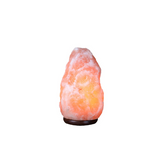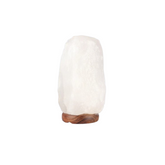History of Himalayan Salt Mining in the Khewra Mine
History of Himalayan Salt Mining in the Khewra Mine
The story of Himalayan pink salt is as ancient as the mountains it comes from. Revered for its distinctive color, mineral richness, and natural purity, this salt has traveled centuries from deep within the Khewra Mine in Pakistan to modern kitchens, spas, and wellness rituals around the world.
In this detailed guide, we trace the history of Himalayan salt mining, exploring its geological origins, historical milestones, and evolution into a global commodity. For anyone curious about the heritage and authenticity of this prized mineral, this article provides the complete context behind its past and present.
What Is the Khewra Mine and Why Is It Important?
The Khewra Salt Mine is the second-largest salt mine in the world and the oldest in South Asia. Located in the Punjab region of Pakistan, near the foothills of the Salt Range, the mine is the primary source of Himalayan pink salt.
The mine is not just a source of salt but a living testament to ancient geological and human history, drawing tourists, researchers, and historians from around the world.
Geological Origins: The Story of Ancient Evaporites
To understand the historical significance of Himalayan salt, we must first look at its geological roots.
Over 600 million years ago, during the Precambrian Era, vast seas covered much of the area now known as Pakistan. As these ancient evaporites (evaporated inland seas) dried up over millennia, thick layers of salt were deposited beneath the earth’s surface.
These salt layers, later compressed and uplifted by tectonic activity, now form the Salt Range, home to the Khewra Salt Mine.
Quick Facts on Himalayan Salt Formation:
- Age: Over 600 million years
- Type: Halite (sodium chloride with trace minerals)
- Formation: Sedimentary rock from evaporated seas
The natural pink hue is due to trace amounts of iron oxide and magnesium, setting it apart from refined table salt.
Historical Timeline of Himalayan Salt Mining
The history of Himalayan salt mining is a fascinating blend of legend, empire, industry, and preservation. Here's a chronological look:
326 BCE – Discovery by Alexander the Great
Legend states that the troops of Alexander the Great discovered the salt deposits when their horses began licking rocks near Khewra during a military campaign. While historical documentation is sparse, this anecdote marks the first known human interaction with Himalayan salt.
Mughal Era – Early Structured Mining (16th–18th Century)
The Mughals developed a more organized method of salt extraction. Basic tools and manual labor were employed to collect salt in small quantities, primarily for regional use.
British Rule – Industrialization (1872 Onwards)
Modern salt mining began under British colonial administration. In 1872, British engineer Dr. H. Warth introduced the “room and pillar” method, a technique still in use today that ensures structural integrity while maximizing yield.
Key Advancements During British Rule:
- Ventilation shafts and drainage systems were built.
- Rail tracks were introduced for salt transportation.
- Mining expanded to export levels.
Post-Independence – Nationalization and Growth (1947–Present)
After Pakistan’s independence in 1947, the Khewra Mine became a government-controlled operation under Pakistan Mineral Development Corporation (PMDC).
Recent Developments:
- Touristic additions like the Salt Mosque and underground clinics for asthma.
- Growing exports to wellness and culinary markets globally.
- Sustainability efforts and modernization of tools.
Mining Techniques: Past and Present
The “room and pillar” mining method remains central to Khewra operations. This involves carving large chambers out of the salt, supported by pillars of untouched salt to prevent collapse.
Traditional Techniques:
- Pickaxes and hand drills
- Oil lamps for lighting
- Manual carting
Modern Practices:
- Electric drills and controlled blasting
- Ventilation and water management systems
- On-site purification and packaging for culinary-grade salt
Cultural and Economic Impact
The Khewra Mine is more than just an extraction site—it's a cultural landmark.
Cultural Significance:
- Salt Mosque: Built entirely from salt bricks.
- Miniature Monuments: Salt replicas of the Great Wall of China and Badshahi Mosque.
- Annual footfall of over 250,000 tourists, including school trips and international visitors.
Economic Importance:
- Employs over 1,100 workers.
- Produces over 387,000 tons of salt annually.
- Supports local and national exports of edible, industrial, and wellness-grade Himalayan salt.
Sustainability and Preservation
Modern mining at Khewra includes a strong focus on sustainability to ensure both safety and longevity.
Key Sustainability Practices:
- Reuse of waste salt for construction or industrial uses.
- Preservation of unused chambers for tourism.
- Environmental compliance and controlled blasting techniques.
As demand grows for authentic Himalayan pink salt, sustainable practices ensure the Khewra Mine continues to operate for generations.
FAQ: People Also Ask
How old is the Himalayan salt in the Khewra Mine?
The salt is estimated to be 600–800 million years old, originating from ancient evaporite beds formed by drying seas.
Is the Khewra Salt Mine open to visitors?
Yes! It's a major tourist site in Pakistan, featuring guided tours, underground mosques, and even a salt therapy chamber.
How is Himalayan salt different from other types?
It is mined rather than evaporated, unrefined, and contains trace minerals like iron and magnesium, which give it its pink hue and distinct flavor.
Is Khewra Himalayan salt safe to eat?
Absolutely. It is chemically similar to table salt, with additional trace minerals. Just like any salt, moderation is key.
Final Thoughts
The Khewra Mine stands as a monumental blend of natural history, human ingenuity, and sustainable industry. From ancient geological events to modern global wellness trends, the history of Himalayan salt mining is a powerful story of continuity and transformation.
As consumers seek authenticity and traceability in what they eat and use, understanding the origins of Himalayan pink salt becomes not just a curiosity—but a connection to deep time and place.
For a broader perspective on Himalayan pink salt’s composition and uses, see our Complete Guide to Himalayan Pink Salt.





